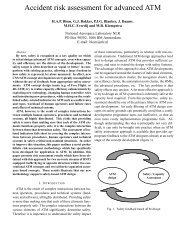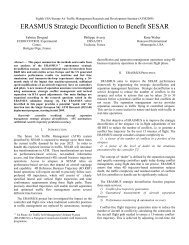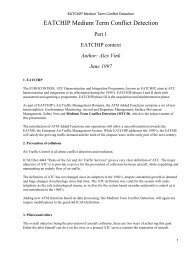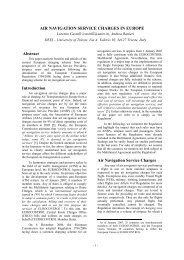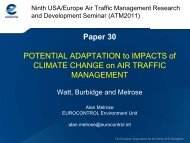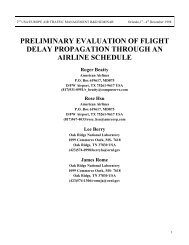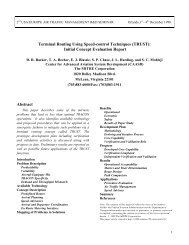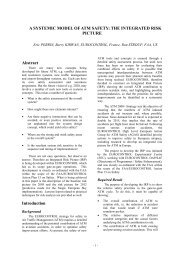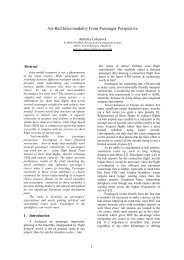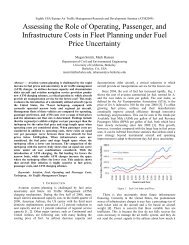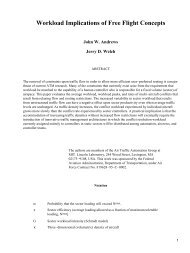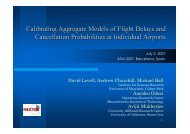a model to solve en route air traffic flow management - ATM Seminar
a model to solve en route air traffic flow management - ATM Seminar
a model to solve en route air traffic flow management - ATM Seminar
- No tags were found...
You also want an ePaper? Increase the reach of your titles
YUMPU automatically turns print PDFs into web optimized ePapers that Google loves.
A MODEL TO SOLVE EN ROUTE AIR TRAFFIC FLOW MANAGEMENTThird, it could be easily adapted <strong>to</strong> cover cases with more than one alternative <strong>route</strong> a for flights i, i∈F a ,considering these <strong>route</strong>s as additional flights and adding the corresponding sums <strong>to</strong> the left side of theconstraints (3).4. PROPOSED SOLUTIONThe LP relaxation approach is used for solving the BIP <strong>model</strong> (1−4). LP relaxation of the BIP <strong>model</strong> is <strong>solve</strong>dusing a standard LP package. If the solution is integer, it is an optimal one and the value of the objectivefunction (1) repres<strong>en</strong>ts the minimum <strong>to</strong>tal delay cost. Otherwise, each flight i with value 1 for correspondingvariable x i,k is served with delay k. Th<strong>en</strong> all flights with non−integer values for some of the correspondingvariables are served by applying one of the heuristic approaches described in Tosic et. al. (1995).5. NUMERICAL EXAMPLEIn this section, results of one of the conducted experim<strong>en</strong>ts will be pres<strong>en</strong>ted in order <strong>to</strong> illustrate theapplication of the developed <strong>model</strong> and proposed method of solution. It is similar <strong>to</strong> the numerical exampleused in Tosic et. al. (1995) were we had N=4 ATC sec<strong>to</strong>rs (North=N, East=E, South=S, West=W) and T=8half−hour time periods with 162 flights in set F each int<strong>en</strong>ding <strong>to</strong> fly <strong>en</strong>−<strong>route</strong> through some of those foursec<strong>to</strong>rs. In this example we introduce two more ATC sec<strong>to</strong>rs, N' and E' (Figure 1) offering two alternativeroutings for the two most loaded <strong>air</strong> <strong>traffic</strong> <strong>flow</strong>s, namely NE <strong>flow</strong> with 45 flights and EN <strong>flow</strong> with 26flights.Those flights are "offered" the following alternative <strong>route</strong>s: for NE flights, the alternative <strong>route</strong> is N'E' and forEN flights the alternative <strong>route</strong> is E'N'. Remaining flights of other <strong>traffic</strong> <strong>flow</strong>s are not offered alternative<strong>route</strong>s. Therefore the initial <strong>to</strong>tal <strong>traffic</strong> load remains the same as in the example used in Tosic et. al. (1995),as well as sec<strong>to</strong>r capacities per period which were set equal <strong>to</strong> Q jt =18 flights (j=1,2,3,4, i.e. j=N,E,S,W andt=1,2,...,8). Sec<strong>to</strong>rs N' and E' have capacities Q 5t =Q 6t =9 (t=1,2,...,8) because of the load produced by flightsflying through those two sec<strong>to</strong>rs on their original <strong>route</strong> (flights not considered in this example), so those twocapacity values should be unders<strong>to</strong>od as remaining sec<strong>to</strong>r capacities.Alternative <strong>route</strong>s N'E' and E'N' are equal in l<strong>en</strong>gth and take 1/3 of a half−hour time period (10 minutes)longer <strong>to</strong> fly than their respective original <strong>route</strong>s NE and EN. It is assumed that all flights originally in NE andEN <strong>flow</strong>s will fly the same extra amount of time wh<strong>en</strong> flying on alternative <strong>route</strong>s for reasons of simplicity.For the same reason, we assume that the ratio of cost per unit time wh<strong>en</strong> the <strong>air</strong>craft is in the <strong>air</strong> and wh<strong>en</strong> it ison the ground equals 4 (Andrews 1993), and this value was used for all flights. We used the same coeffici<strong>en</strong>tsc i as in the previous example, Tosic et. al. (1995) where the function of <strong>air</strong>craft size giv<strong>en</strong> ranged from 0.1 for<strong>air</strong>craft up <strong>to</strong> 15 seats <strong>to</strong> 4.0 for <strong>air</strong>craft with 320 <strong>to</strong> 450 seats. We have therefore the following values forcoeffici<strong>en</strong>ts c i '(k) and c i " in objective function (1): c i '(k)=c i ⋅k and c i "=4⋅1/3⋅c i =4/3⋅c i . Maximum permittedground delay per flight i was set at k i * =4 half−hour time periods and was assumed equal for all flights. Th<strong>en</strong>,maximum permitted delay for flights i on alternative <strong>route</strong>s a was calculated as k a * =int(k i * − 1/3)=3 and wasalso assumed equal for all flights assigned <strong>to</strong> alternative <strong>route</strong>s.4



